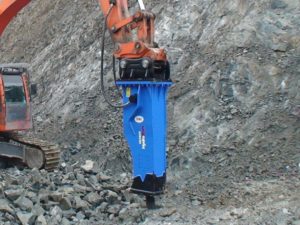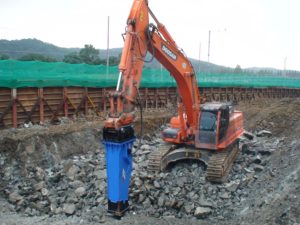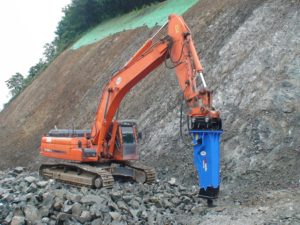Hydraulic hammers/breakers are essential pieces of equipment in the construction equipment industry. They are used in both building and demolition for the construction industry. For construction, they can be used to dig holes, breaking up rock, or breaking the dirt to dig a hole more easily.
When performing demolition, the hammer/breaker can quickly break up concrete, walls, and foundations to bring down various structures. Since hammers/breakers can break through hard material easily, these types of tools are great for the mining industry.
Hammers/breakers are often mounted to skid steers, mini-excavator, loader backhoes, and large-sized excavators. These tools are great for building and demolition. The most interesting thing about these hammers/breakers though is how they work.
The Science Behind a Hydraulic Hammer | Breaker
Hydraulic hammers/breakers use hydraulics to work, which is the reason behind their name, but it is also what sets them apart. Pascal’s law, which is a mechanical principle in mechanics, is the basic function of the hydraulic hammer. By putting pressure on one part of a fluid, it transfers the pressure to all areas of the fluid, which multiplies the force.
Hydraulic Hammers | Breakers uses hydraulic oil, which cannot be compressed, with pressure stored in a small canister. This hydraulic system supplies the force for hitting. Regular, hand-held hammers don’t even compare to the strike of a hydraulic Hammer | Breakers.
There are two main types of hydraulic hammers | breakers, with different valves. One type has an inner valve while the second type has an outer valve. The inner parts are mostly the same, with the necessary cylinder to provide the pressure and a piston to convert the energy into the hammering action. Other similar hydraulic parts include:
- Side rods: designed for supporting mounted hammer applications
- Nitrogen Chamber: a low-pressure chamber to help supply power
- Main Valve: the only moving part, other than the piston, to help hammer
- Front Cap: keeps the hammer attachment in place during impact
Hydraulic Hammer Classes
Hydraulic Hammers | Breakers come in different sizes/classes to fit a variety of jobs. Each one has a recommended usage amount to help users know which class is best for each job. While each hammer/breaker will have a different measurement depending on the brand, here are some basic stats on each class that you can see their potential impact on a job:
- Small class: The impact frequency on this size is anywhere from 400 to 1200 BPM with a 1400 to 2175 PSI
- Medium class: The impact frequency here is 370-700 BPM with a 2175 to 2610 PSI
- Large class: This size has an impact frequency of 200 to 400 BPM with a 2300 to 2610 PSI
These measurements show the number of times the hammer can hit the target in a minute, along with how much pressure is used. It is important that the right class hammer is used for each job. Using a hammer/breaker with too much pressure for a job that requires less can do too much damage.
If you are in the market for a hydraulic hammer/breaker and have any questions about what size is right for your project, we are always here to answer those questions via [email protected]



